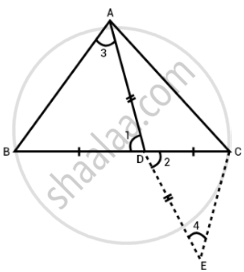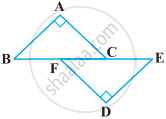Advertisements
Advertisements
प्रश्न
Prove that sum of any two sides of a triangle is greater than twice the median with respect to the third side.
उत्तर
Given: In triangle ABC with median AD,
To proof: AB + AC > 2AD
AB + BC > 2AD
BC + AC > 2AD
Producing AD to E such that DE = AD and join EC.
Proof: In triangle ADB and triangle EDC,
AD = ED ...[By construction]
∠1 = ∠2 ...[Vertically opposite angles are equal]
DB = DC ...[Given]
So, by SAS criterion of congruence]
ΔADB ≅ ΔEDC
AB = EC ...[CPCT]
And ∠3 = ∠4 ...[CPCT]
Again, in triangle AEC,
AC + CE > AE ...[Sum of the lengths of any two sides of a triangle must be greater than the third side]
AC + CE > AD + DE
AC + CE > AD + AD ...[AD = DE]
AC + CE > 2AD
AC + AB > 2AD ...[Because AB = CE]
Hence proved.
Similarly, AB + BC > 2AD and BC + AC > 2AD.
APPEARS IN
संबंधित प्रश्न
ABC is an isosceles triangle with AB = AC. Drawn AP ⊥ BC to show that ∠B = ∠C.
In two right triangles one side an acute angle of one are equal to the corresponding side and angle of the other. Prove that the triangles are congruent.
Prove that in a quadrilateral the sum of all the sides is greater than the sum of its diagonals.
In the following figure, BA ⊥ AC, DE ⊥ DF such that BA = DE and BF = EC. Show that ∆ABC ≅ ∆DEF.

ABC and DBC are two triangles on the same base BC such that A and D lie on the opposite sides of BC, AB = AC and DB = DC. Show that AD is the perpendicular bisector of BC.
In a right triangle, prove that the line-segment joining the mid-point of the hypotenuse to the opposite vertex is half the hypotenuse.
Two lines l and m intersect at the point O and P is a point on a line n passing through the point O such that P is equidistant from l and m. Prove that n is the bisector of the angle formed by l and m.
Line segment joining the mid-points M and N of parallel sides AB and DC, respectively of a trapezium ABCD is perpendicular to both the sides AB and DC. Prove that AD = BC.
ABCD is a quadrilateral such that diagonal AC bisects the angles A and C. Prove that AB = AD and CB = CD.
ABC is a right triangle such that AB = AC and bisector of angle C intersects the side AB at D. Prove that AC + AD = BC.
